A Metro committee voted this morning to recommend $141.6 million to a variety of transportation programs, plans, and projects. The funding comes from two federal grant programs and are known as Regional Flexible Funds.
Among the $49.3 million in capital projects recommended for funding was $8.7 million for the Historic Trolley Trail Bridge between Gladstone and Oregon City. This $10.4 million project will erect a new, carfree bridge over the Clackamas River and provide the missing link of the Trolley Trail. The bridge alignment will connect an on-street portion of the Trolley Trail route on Portland Avenue in Gladstone directly to the Clackamas River Trail and Trolley Trail path in Oregon City.
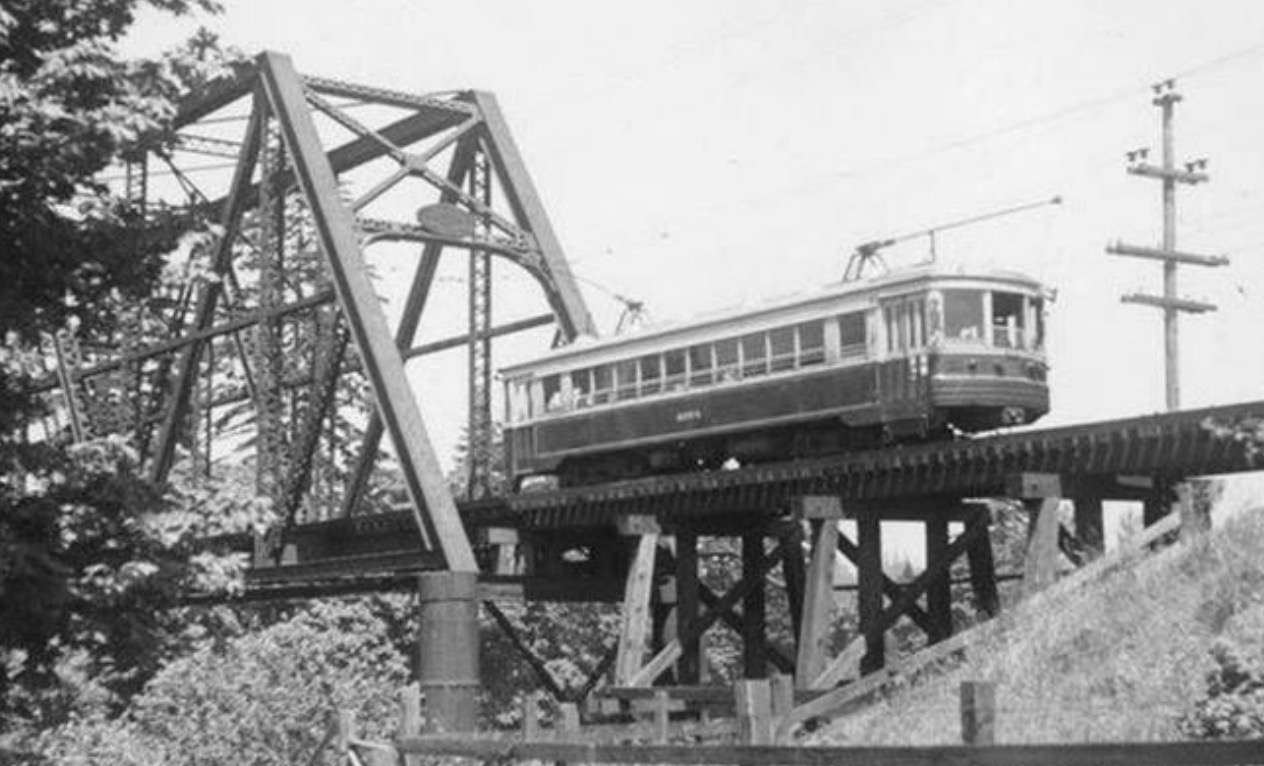
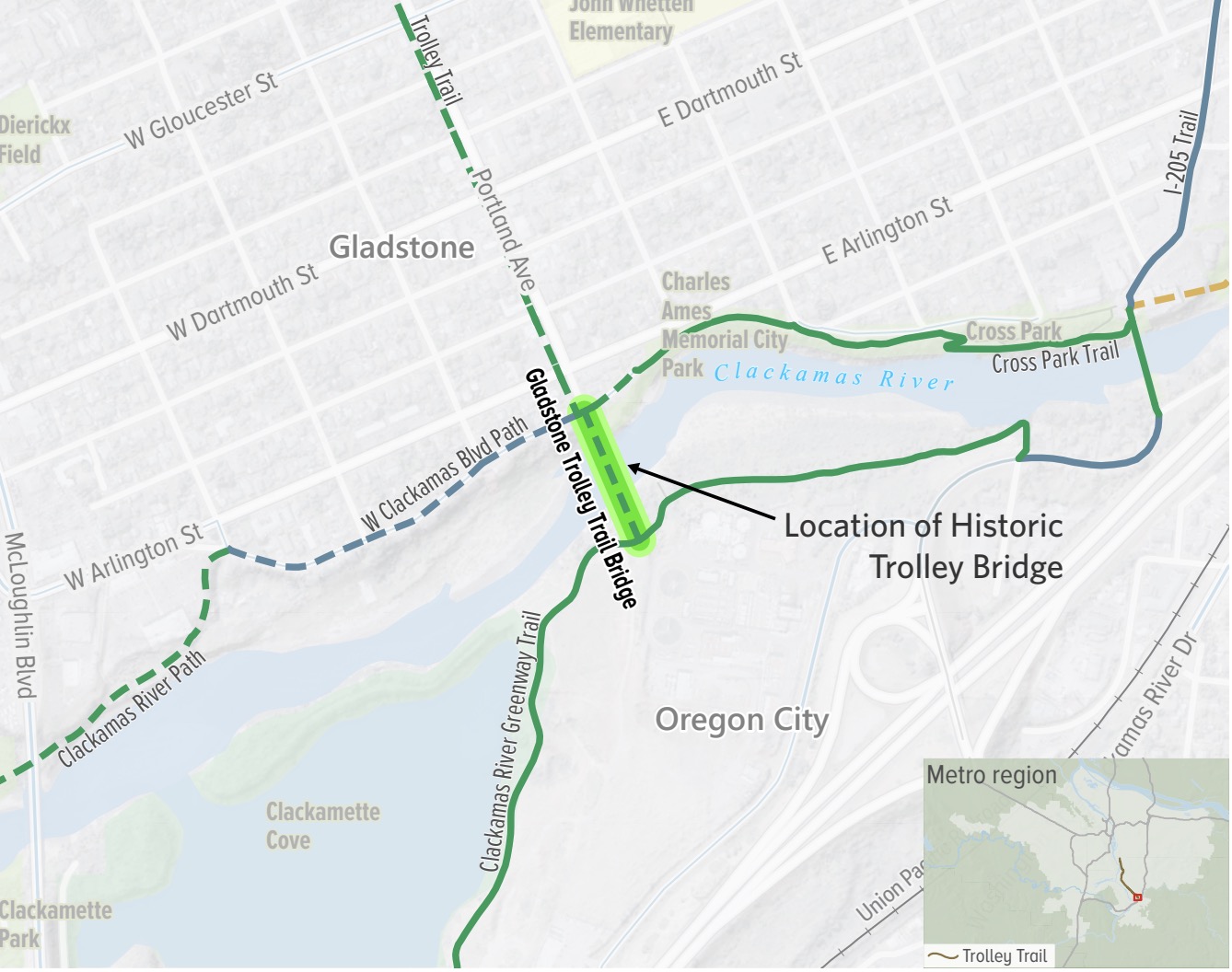
The Gladstone Trolley Trail Bridge originally opened in 1908 (see above) and served passenger and freight electric railway cars until 2014 when damage forced its closure. Back then, Metro and other regional trail advocates hoped the old bridge could be rebuilt and used for a rail-trail. But it was too heavily damaged and was removed from the river that same year.
The new crossing will give rollers and walkers a much more direct and safer route along the Trolley Trail. An existing carfree bridge just a half-mile to the east (at 82nd Dr) adds a mile to the route, and riding on McLoughlin Blvd (99E) is very stressful. Once the new bridge is in place it’s estimated to see 489,000 annual users and reduce 12 tons of greenhouse gas emissions per year. Combined with the existing 82nd Drive bridge, it will provide a carfree riverfront loop.
Metro’s Transportation Policy Advisory Committee (TPAC) voted to devote $8.7 million grant to the project, thus competing funding. Metro says final design and construction are likely to begin this year.
In the same vote, $92.3 million was awarded to a mix of region-wide transportation program investments like Safe Routes to School, Transit Oriented Development, and corridor planning. Of that, $51.7 million was awarded to bonding commitments for a suite of projects that includes: TriMet’s 82nd Avenue Transit Project, TriMet’s Tualatin Valley Highway Transit Project, Portland Streetcar Montgomery Park Extension, ODOT’s Sunrise-Gateway Corridor Project, and the County’s Earthquake Ready Burnside Bridge Project.
Other projects recommended for funding this morning include:
- NE 223rd Ave: NE Glisan to NE Marine Dr Safety Corridor Planning Multnomah County – $897,300
- NE Glisan St: 82nd Avenue Multimodal Safety and Access Portland – $7,577,698
- NW Division Street Complete Street: Gresham-Fairview Trail – Birdsdale Avenue Gresham – $4,067,495
- NE MLK Jr Blvd Safety and Access to Transit Portland – $4,879,517
- Cedar Mill Better Bus and Access to Transit Enhancements Washington County – $5,252,300
- Westside Trail Pedestrian and Bicycle Bridge Over Highway 26 Tualatin Hills Parks & Recreation District – $5,000,000
- North Dakota Street (Fanno Creek) Bridge Replacement Tigard – $8,000,000
- Railroad Avenue Multiuse Path: 37th Avenue to Linwood Avenue Milwaukie – $2,707,217
- OR99E (McLoughlin Boulevard) 10th Street to tumwata village: Streetscapes Enhancements Project Development Oregon City – $2,232,341
From TPAC, the recommended projects will move to Metro’s Joint Policy Advisory Committee on Transportation (JPACT) and then to Metro Council where they’ll be officially adopted later this year.
Stay tuned for more on each of these projects!


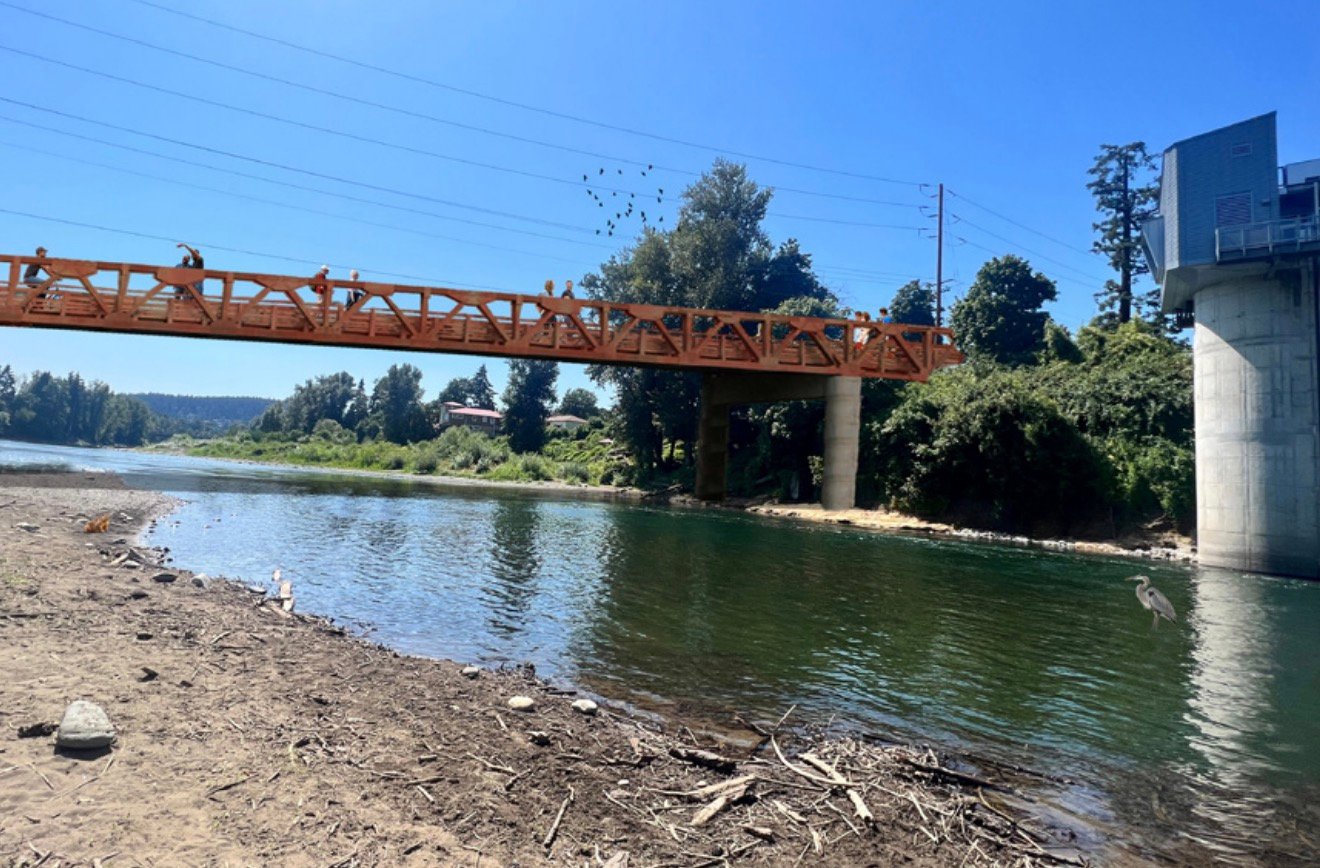
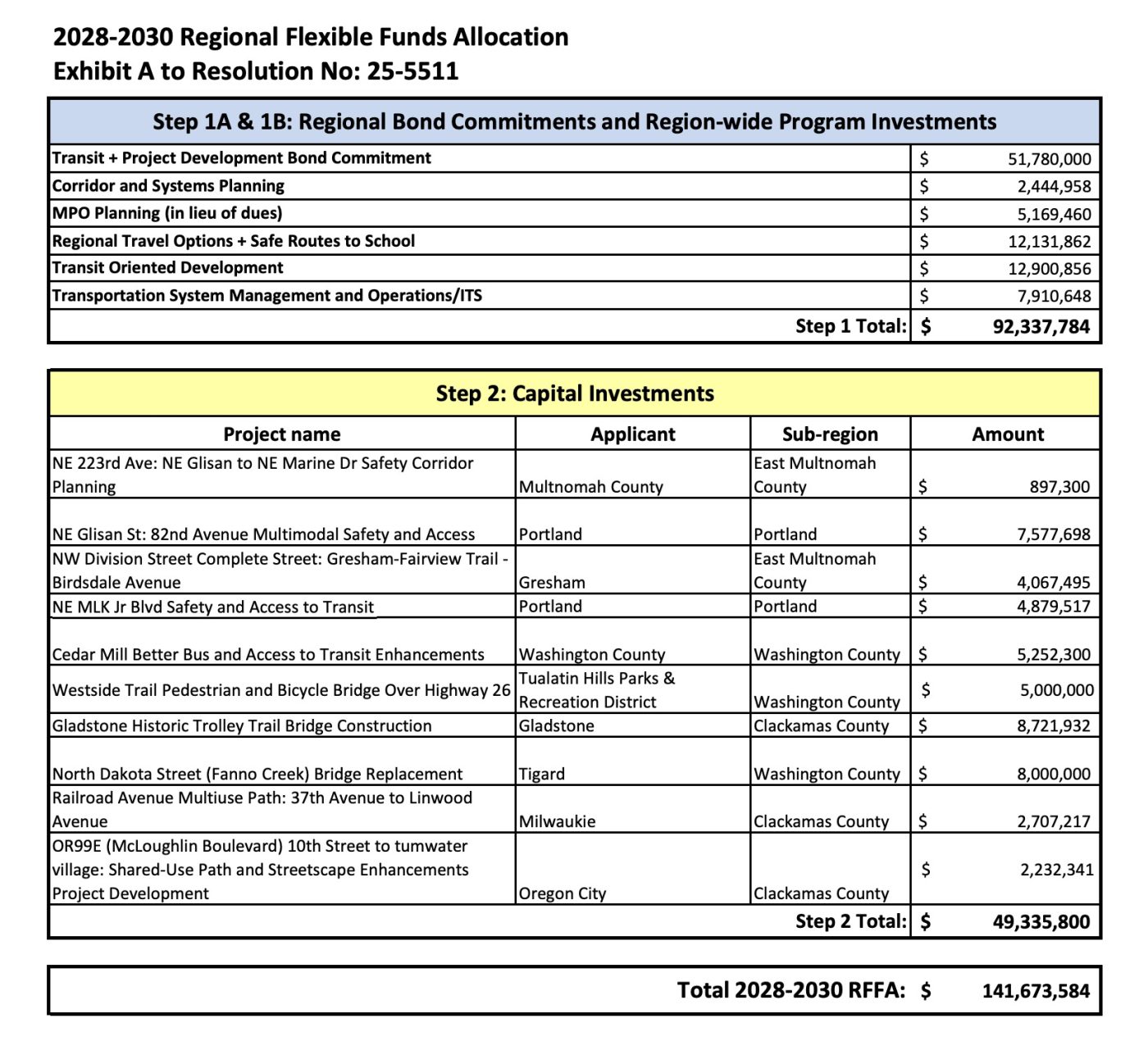
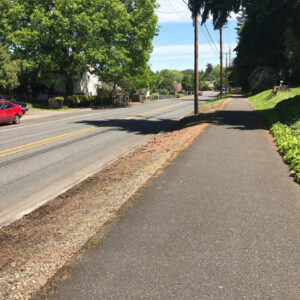
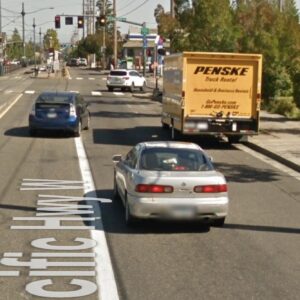
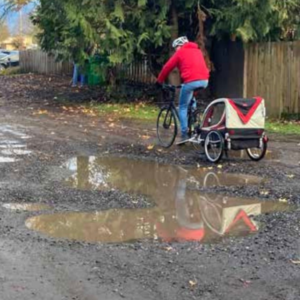
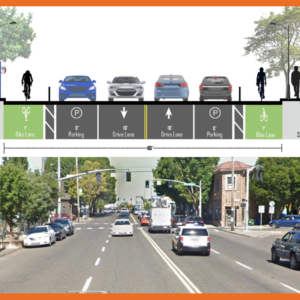
Thanks for reading.
BikePortland has served this community with independent community journalism since 2005. We rely on subscriptions from readers like you to survive. Your financial support is vital in keeping this valuable resource alive and well.
Please subscribe today to strengthen and expand our work.
The estimate that the highlighted bridge will be crossed at a rate of ~ 0.5 M people/year seems optimistic to me. (If I multiplied correctly, that’s about 1 crossing per minute on average.) I hope it sees that kind of use!
On the one hand- this connection will make a nice walking loop possible, and it’s a more direct connection from Gladstone to OC. Great!
On the other hand, there’s already a low stress route from Portland Avenue east to the existing pedestrian bridge, so riding along McLoughlin isn’t necessary to connect these two riverfront parks.
So, in terms of the best bang for the buck, I wouldn’t have chosen this project. That said, I don’t know all details, or all the projects that didn’t get recommended.
(Personally I am very happy they recommended the Railroad Avenue multi use path in Milwaukie- there is no shoulder *or* sidewalk along this road, and it’s a high speed road).
Stop thinking that biking doesn’t deserve redundant routes! That other bridge requires an additional mile out of direction travel and once this one is built, it will create a riverfront loop for all these local folks and will open up vast potential for walking and rolling!
I don’t think Charley is approaching this from the perspective that biking doesn’t deserve multiple routes, but more so there are so many other locations that don’t have any viable routes.
Because this is getting funded by transportation dollars, it’s reasonable to critique this bridge through a utility lens.
OK I hear that. But I hear this type of critique a lot and the scarcity mindset among many bike advocates is something worth working on. This is a grant program, so it’s up to project advocates to do their homework, submit a great application, and hope for the best. It bugs me when someone does something great and wins funding for a cool project, only to have some folks question its necessity. There will ALWAYS be other projects to do. We can and should fund all of them and I think we should be careful before dissing one because something else didn’t get funded.
Until the various levels of government agencies align their spending with their stated goals, it is not unreasonable to have a scarcity mindset because there is only a pittance of funding going around.
The more pessimistic outlook is that so little amount of the budget is spent on bike/transit projects, that nothing we can build will move the needle at all. I reject that idea and truly believe we can make a huge impact with what little funding we have but it’s worthwhile to be critical of what we do spend money on.
I’m not saying whether this project should or shouldn’t be built, but pessimism/criticism does not feel misplaced in the current environment. Especially when there have been other vanity bridge projects that serve a dubious transportation utility built in the past (looking at you red electric bridge).
I wholeheartedly agree Daniel, with the caveat that I think that would mean we accepted a different (i.e., iterative) process and more ad hoc design elements that are used in cities other than Portland.
If the city truly wanted to move the needle on the number of people who bike we could do it next week. Buying–or allowing advocates to buy–a hundred planters and add diverters on every block of SE Ankeny, or ahem separate a bike lane on NE Broadway, would cost the city paint and political capital.
But the real problem is that PBOT/the city has no feasible plan to increase biking (regardless of budgetary restrictions), nor is it something that the mayor or council members are willing to spend political capital on.
Sorry, JM, but I’m with Charley here. The fact that there is ALREADY a car-free bridge within spitting distance means that other projects in other locations should be prioritized.
You live in a part of town that has so much bike infra, relative to other parts, that you’ve obviously adopted Ezra Klein’s “abundance” mindset, which says we can have everything all at once. But obviously we can’t – and people who have little or nothing know that fact better than anyone.
A better example from the list is the Westside Trail crossing of Highway 26. That bridge is needed much more than the redundant Trolley Trail bridge.
Fair points!
I do think the loop will be popular, just like the Steel/Hawthorne loop in downtown Portland is for runners.
Also, it occurs to me that with our ancient bridge infrastructure, any new bridges could provide a critical link in the event of an earthquake. In that case, the resiliency value of an additional bridge may outweigh its redundancy.
Still, all things being equal, I’d usually rather see the money go to improving subpar bike/ped facilities or adding bike/ped facilities to dangerous roads. I also realize “things” may not be equal.
An example: why is there no bike path or even sidewalk on SE McLoughlin from SE Tacoma up to SE Harold? There’s no property ownership problem: it’s a state highway, a grassy field, and Trimet tracks.
I’m guessing the road was built during the Olmsted era, but hasn’t it occurred to anyone that the damn road still does not even have a sidewalk? The parallel route has one cross the highway twice, and the whole way is on bumpy, terrible pavement.
As nice as I’m sure the new bridge will be, in terms of priority, I can’t believe it will yield more value than allowing me to avoid riding my bike on the tiny shoulder of a state highway?
I heard there were plans to run that multiuse path that starts at 17th all the way down to Tacoma as part of the Orange Line build. There was plenty of money left over to do it (later returned to the feds), but ODOT killed the plan. They want to keep the land open to potentially add more lanes to McLoughlin. That will not go over well if it ever were to happen as all those trees lining McLoughlin through that area would have to be cut down.
“They want to keep the land open to potentially add more lanes to McLoughlin.”
Well, that would be… $&@&1^#^ dumb.
The traffic back up that happens there on the morning commute time happens because of all the red lights downstream. What would three lanes accomplish? Good lord that is so dumb.
I feel the same way. I suspect the jurisdiction/funding sources are different, but if I could put this money towards any bridge, I’d put it towards rebuilding the trestle at the end of the Cazadero trail to finally allow a safe route to Milo McIver and the Cascading Rivers Scenic Bikeway. Me and friends all have had close calls on the roads that circumvent the missing Cazadero trestle coming to/from the Springwater.
It should be noted that if this bridge comes in at budget, it’s only half the cost of the proposed bridge over N. Columbia Blvd.
Hopefully this bridge spurs Gladstone to rethink Portland Ave, it’s such a crazy wide road for how little car traffic there is
Doesn’t the width make it nice for cycling? I enjoy cycling on it.
Not so much if you have to bike in traffic that’s expecting to go 25-30mph. I used the side street when I went biked down there a while back since it was much more peaceful.
But if it’s getting very little traffic as Alex says, the perhaps they could remove the center turn lane, move the parking lanes toward the center, and put bike lanes down the sides between parking and the curb.
Speed limit is 20mph on portland ave. But, yes it is crazy wide…Wide enough that the trolley trail could easily continue as a MUP from abernathy to portland ave. The fire department is also on portland ave, so that section may be difficult to maintain easy entry/exit for the trucks if there are parking lanes in the center.
FWIW there is already a pretty large no-parking zone in front the department and around the corner, so even with this change trucks would have a lot of room (though they might have to eliminate that one stop across the street).
489,000 annual users! Wow. Busy place. Doesn’t Hawthorne bridge get less than 10k bikes per year, so this bridge would have 50x the traffic. I must be missing something.
Probably will get a lot of pedestrian traffic too.
Hawthorne Bridge gets ~1M bikes in a year (note that the data here seemingly only has reliable counts westbound, so I doubled it when looking at the last 12 months). Tilikum seems to have slightly more reliably counters and gets ~700k cyclists.
I imagine the specifics of this bridge being short and well located for recreational use contribute to the high estimates.
If there are better projects out there…
Be the champion, build coalitions, form partnerships, seek letters of support, lobby neighborhood and business groups, provide public testimony, follow the funding opportunities, fill out the grant applications, etc, etc, etc. Start with small grants and parlay those into larger grants…
Yes, there is barley enough alt-transportation funding to make a difference. As advocates, lest us not circle the wagons and shoot inwards, but rather make our outposts a place of support and make them as large and as inclusive as possible.
Yes! x100! Let’s celebrate a win. While I think the BP comments have some of the best discussion on the internet, I’m always surprised by how much negativity about the bike infrastructure there is (the greenways don’t have enough diverters, parking protected bike lanes expose one to right hooks, sometimes you have to press a button to get a green light, homeless people leave stuff on the paths, etc., etc.).
In this case it’s the mediocre that is the enemy of the good. We have a map with colored lines on it but many of those lines point to streets with a level of service for active transportation that is little better than any other street in the grid. Some of the designated streets are very questionable choices.
For me there WAS a far better project – the RR Ave 37th – Linwood MUP. Fortunately it was funded. So I’m not complaining. The project that was most important to me and my neighbors – we pressed hard for it – and it was funded. But $8.7m for a ped/bike bridge a few blocks from another ped/bike brigde in a “less populated” area? I wish there was something more deserving. However – it will be great for Gladstone residents – Oregon City residents? Maybe.
These bike/pedestrian bridges should point a way towards downsizing the Rose Quarter Project while retaining the stated goal of reconnecting communities. Based on this bridge and the Columbia Blvd bridge, a bike/pedestrian bridge at 10 cross streets would cost ~$100-200 million. Far less than the proposed caps. It could also reconnect a larger part of the city.
Build the Oak Grove-Lake Oswego bridge you cowards!
(Yes I did fill out the survey)
Utility wise, this is way way low on my personal list, even as someone who lives very near the trail. But I guess it will make for a nice little recreational loop for neighborhood folks. The Railroad Ave improvements will be a much bigger connectivity upgrade for more people.
This x1000
HAHA yeah! I excitedly thought this was about such a bridge until I clicked through.
This seems like a great bridge too, I will def. use it